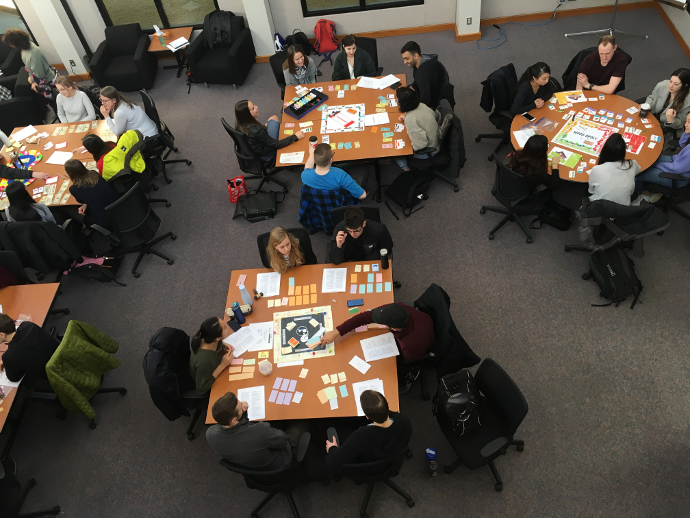We’ve Got Game
Sarah Kent - 14 August 2020

It’s more than fun and games for University of Alberta Faculty of Law students during several inventive classes that use game-based learning techniques to teach property law and the history of the Constitution.
In Professor Péter Szigeti’s property law class, students unleash their creativity designing Monopoly boards to understand property law concepts while students in Professor James Muir’s legal history course role-play as delegates to the confederation and the patriation of Canada’s Constitution.
“It was wonderful to come into the law school and see professors experimenting with their subject matter,” says Hero Laird, ‘22 JD, a student in Szigeti’s 2020 class.
Game-based learning is a growing trend in higher education as studies of learning have established that game play is an effective teaching method. But game-based learning is not new; learning is already a core component of most games. Chess teaches strategy, puzzles teach problem-solving and multi-player games teach collaboration. Mooting, which has been a source of pride at UAlberta Law, is also a form of role-playing.
Game-based learning is a perfect fit for law, says Szigeti. Strategic thinking is a cornerstone of legal practice, and games like Monopoly build on that. The ability to advocate for a variety of positions, necessary for Muir’s course, is also fundamental to law.
Property Law Monopoly
Szigeti’s Monopoly assignment has been almost a year in the making. “I did go on some research and fact-finding missions in the summer to (Edmonton’s) Hexagon Board Game Café.” He chose Monopoly for its alignment with property law and its status as a classic board game.
The Monopoly assignment for his class is based on Property and Justice, a book by legal academic James Harris, which contemplates how property in non-Western or non-capitalist societies might take on definitions different than those typical in the Western world.
Each group of students is responsible for designing a game based on a fictional society in which the idea of property is reimagined.
In “Redopoly,” there was no such thing as private property. “Everything is owned by all,” read that group’s rule book. The goal was to acquire as much “happiness” as possible while avoiding starving to death. In “Deadmonton,” an apocalyptic world, life and death hung in the balance when acquiring property. Any time a player landed on a property, they could battle the landowner with a game of dice to dodge paying taxes.
“For me, the game was a really neat way of realizing — in a different way — how much of society depends on how we decide to distribute property and resources,” says Laird.
Szigeti hopes that in addition to energizing the class and breaking away from the traditional lecture format, the assignment allows the students to learn from each other. “The best teaching happens when students get each other interested in a certain topic,” he says.
His students agree. “Including play in learning is an incredibly powerful strategy,” says Laird, who wants to see more game-based learning incorporated into law courses. Szigeti has plans to design a property law course entirely devoted to game-based learning.
Legal History Role-Playing
Muir’s class starts with students negotiating the Confederation agreements of 1864-1867. In its second half, students role-play as delegates for the patriation negotiations of 1981 that led to the Constitution Act, 1982. Students assume the identities of representatives for government or non-governmental organizations.
One of the learning outcomes is for students to understand the Constitution in its historical context by giving them a taste of the patriation negotiations. “The Constitution is a historical document created by a small group of people at a particular moment in time,” says Muir. “It is a fallible document.”
During the term, representatives of the Federal Patriation committee have an uphill battle catering to the different wants and needs of the provinces and non-governmental organizations.
Debate was fierce on the reenactment of opening day. During that class, the federal government presented its initial proposal and delegates had the opportunity to advocate for their interests.
“As Alberta, we are tired of getting the short end of the stick from the federal government,” said delegates of Alberta. “We thank God we have universal health care because we’ve been breaking our backs supporting this country.”
Meanwhile, “We do not support the expansion of bilingualism in Canada,” said representatives of Quebec, who advocated for protecting the province’s francophone heritage. “We don’t want the federal government breathing down our provincial necks.”
The “Patriation Conference 1981 Game” is in its ninth iteration, having transformed significantly since 2011, when Muir and Professor Peter Carver first co-taught the course. Muir refines it every year, tweaking the gameplay and assignments.
“This class was like no other course I have taken,” says Tracy Zimmer, ‘20 JD, who represented the Canadian Teachers Federation in the negotiations. “The interaction of this class went beyond someone telling you Canada's history and put you in the midst of the action.”
“The final learning objective of the course is that they have fun,” says Muir. “In some ways, that is the primary objective. If they have fun, the other learning objectives will come along with that.”